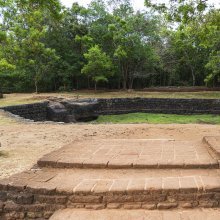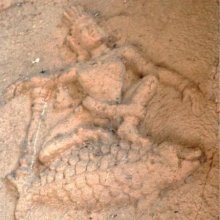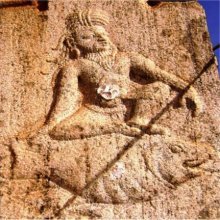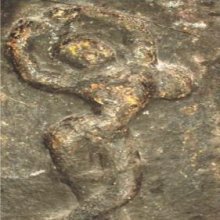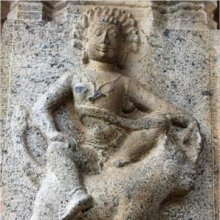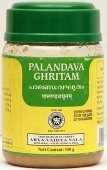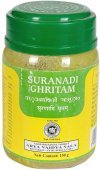Patta, Paṭṭa, Pāṭṭā, Pāttā: 33 definitions
Introduction:
Patta means something in Buddhism, Pali, Hinduism, Sanskrit, Jainism, Prakrit, the history of ancient India, Marathi, Hindi, biology, Tamil. If you want to know the exact meaning, history, etymology or English translation of this term then check out the descriptions on this page. Add your comment or reference to a book if you want to contribute to this summary article.
Alternative spellings of this word include Patt.
Images (photo gallery)
(+15 more images available)
In Hinduism
Purana and Itihasa (epic history)
Source: archive.org: Shiva Purana - English TranslationPaṭṭa (पट्ट) refers to “silken (garments)”, according to the Śivapurāṇa 2.3.42 (“Description of the meeting of the Lord and the Mountain”).—Accordingly, as Brahmā narrated to Nārada: “[...] Seeing Śiva in front, Himavat bowed to Him. The mountains and the Brahmins bowed to Sadāśiva. He was seated on his bull, fully bedecked in ornaments and beaming in the face. The beauty of his divine person illuminated the quarters. His body shone in the delicate silken garments (paṭṭa-vastra). His crown was lustrous with the gems set in it. He was smiling shedding pure brilliance everywhere. [...]”.
Source: Cologne Digital Sanskrit Dictionaries: The Purana IndexPaṭṭa (पट्ट).—A plate or cloth or other substance to be presented with prescribed mantras as gift during an eclipse.*
- * Matsya-purāṇa 67. 21.

The Purana (पुराण, purāṇas) refers to Sanskrit literature preserving ancient India’s vast cultural history, including historical legends, religious ceremonies, various arts and sciences. The eighteen mahapuranas total over 400,000 shlokas (metrical couplets) and date to at least several centuries BCE.
Shaktism (Shakta philosophy)
Source: Google Books: ManthanabhairavatantramPaṭṭa (पट्ट) refers to “cloth” (i.e., one who wears cloth), according to the Manthānabhairavatantra, a vast sprawling work that belongs to a corpus of Tantric texts concerned with the worship of the goddess Kubjikā.—Accordingly, “The teacher in the western house is one who belongs to the sequence of the line (of teachers). [...] He is adorned with a white garland and his limbs are smeared with lead paste. He holds a stick and wears anklets. Being a yogi thus mounted on the proclamation of the Kula (teachings), he wears a hat and cloth [i.e., paṭṭa—ṭopikāpaṭṭaṃ] and wanders in the sacred sites (of the Eight Mothers) (engaged) in the practice of the Lords of the Heroes. [...]”.
Source: academia.edu: Women in Early Śākta TantrasPaṭṭa (पट्ट, “turban”) is commonly seen on yoginīs such as Kaumarī, according to Siddhayogeśvarīmata(29.34–40).—The word paṭṭa may also denote a kind of headband rather than a turban. It is a piece of cloth to tie the hair with, and can be applied in many different ways.

Shakta (शाक्त, śākta) or Shaktism (śāktism) represents a tradition of Hinduism where the Goddess (Devi) is revered and worshipped. Shakta literature includes a range of scriptures, including various Agamas and Tantras, although its roots may be traced back to the Vedas.
Vastushastra (architecture)
Source: OpenEdition books: Architectural terms contained in Ajitāgama and RauravāgamaPaṭṭa (पट्ट) [or paṭṭikā, paṭṭī] refers to “- 1. band (molding) §§ 3.6, 15; 4.7. - 2. net (molding) §§ 3.11, 23, 25. - 3. thin plinth § 3.3. - 4. swing bar of a door (= skandhapaṭṭikā) (Aj) § 3.38.—See kṣudra o , mahā o”.—(For paragraphs cf. Les enseignements architecturaux de l'Ajitāgama et du Rauravāgama by Bruno Dagens)

Vastushastra (वास्तुशास्त्र, vāstuśāstra) refers to the ancient Indian science (shastra) of architecture (vastu), dealing with topics such architecture, sculpture, town-building, fort building and various other constructions. Vastu also deals with the philosophy of the architectural relation with the cosmic universe.
Kavya (poetry)
Source: OpenEdition books: Vividhatīrthakalpaḥ (Kāvya)Paṭṭa (पट्ट) in Prakrit refers to a “rice tablet”, while the same word in Sanskrit refers to a “plate (with the twenty-four Tīrthaṅkaras)” or “stone slab”, as is mentioned in the Vividhatīrthakalpa by Jinaprabhasūri (13th century A.D.): an ancient text devoted to various Jaina holy places (tīrthas).—Cf. Sanskrit paṭṭikā “table” of the Jaina law (CDIAL 7699).
Source: Brill: Śaivism and the Tantric Traditions (kavya)1) Paṭṭa (पट्ट) refers to the “panel (of a door)”, according to Bāṇa’s Kādambarī (p. 225).—Accordingly, while describing the shire of the Goddess Caṇḍikā, “[Then the portal to the sanctum sanctorum, a riot of colour and form:] She was being illuminated by the entrance, on which there were hanging cloths reddened by lamp-smoke, a row of bracelets made of peacock-throats festooned [over it], a garland of bells closely-set and pale with powdered flour-cakes, which supported two door-panels (kapāṭa-paṭṭa-dvaya), [studded] with tin lion heads with thick, iron pins in their centers, barricaded with an ivory-rod bolt, carrying [what seemed to be] a necklace of sparkling bubbles that were mirrors oozing yellow, blue and red [light]”.
2) Paṭṭa (पट्ट) refers to a “turban”, according to Bāṇa’s Kādambarī (p. 225-226).—Accordingly, while describing the shire of the Goddess Caṇḍikā, “[Then follows the image of the Goddess Caṇḍikā, which matches the conception of Kālarātri in the passage from the Mahābhārata:] [...] she bore the coquettish apparel of a woman going out to meet Mahākāla at night, [...] with a forehead on which there was a tilaka dot of vermillion made by a Śabara beauty, covered by a magnificent gold turban (cāmīkara-paṭṭa). She was worshipped by goats... mice... antelope and black serpents... She was praised on all sides by flocks of old crows; [...]”.

Kavya (काव्य, kavya) refers to Sanskrit poetry, a popular ancient Indian tradition of literature. There have been many Sanskrit poets over the ages, hailing from ancient India and beyond. This topic includes mahakavya, or ‘epic poetry’ and natya, or ‘dramatic poetry’.
Jyotisha (astronomy and astrology)
Source: Wisdom Library: Brihat Samhita by VarahamihiraPaṭṭa (पट्ट) or Paṭa refers to a “gold ornament for the forehead”, according to the Bṛhatsaṃhitā (chapter 2), an encyclopedic Sanskrit work written by Varāhamihira mainly focusing on the science of ancient Indian astronomy astronomy (Jyotiṣa).—Accordingly, “A true Astrologer is also one who has thoroughly mastered the Science of Saṃhitā. [...] It also treats of the prediction of events from the flight of the kañjana and from the appearance of various abnormal phenomena, of expiatory ceremonies; of miscellaneous planetary phenomena; of ghṛta-kambala; of the royal sword; of paṭa; of the features of a house cock, a cow, a sheep, a horse, an elephant, a man and a woman. It also treats of the treatment of women; of moles in the body; of injuries to shoes and clothes; of hairy fans; of walking sticks: of beds and seats; of lamplight; of tooth brush and the like”.

Jyotisha (ज्योतिष, jyotiṣa or jyotish) refers to ‘astronomy’ or “Vedic astrology” and represents the fifth of the six Vedangas (additional sciences to be studied along with the Vedas). Jyotisha concerns itself with the study and prediction of the movements of celestial bodies, in order to calculate the auspicious time for rituals and ceremonies.
Sports, Arts and Entertainment (wordly enjoyments)
Source: archive.org: Syainika Sastra of Rudradeva with English Translation (art)Paṭṭa (पट्ट) refers to the “silken (jesses)” (fastened to the feet of hawks)”, according to the Śyainika-śāstra: a Sanskrit treatise dealing with the divisions and benefits of Hunting and Hawking, written by Rājā Rudradeva (or Candradeva) in possibly the 13th century.—Accordingly, [while discussing the treatment of hawks]: “Finding the birds healthy and well-developed, [...] when they look like snakes which have just cast off their old sloughs, when with their feet fastened with silken jesses (paṭṭa-pāśa) they assume variegated colours from the rays of the jewels in their golden necklaces, their leg rings resound with small bells, [...] their owner should then call them on auspicious day. [...]”.

This section covers the skills and profiencies of the Kalas (“performing arts”) and Shastras (“sciences”) involving ancient Indian traditions of sports, games, arts, entertainment, love-making and other means of wordly enjoyments. Traditionally these topics were dealt with in Sanskrit treatises explaing the philosophy and the justification of enjoying the pleasures of the senses.
In Buddhism
Mahayana (major branch of Buddhism)
Source: De Gruyter: A Buddhist Ritual Manual on AgriculturePaṭṭa (पट्ट) refers to “(decorative) ribbons” (suitable for an offering ceremony), according to the Vajratuṇḍasamayakalparāja, an ancient Buddhist ritual manual on agriculture from the 5th-century (or earlier), containing various instructions for the Sangha to provide agriculture-related services to laypeople including rain-making, weather control and crop protection.—Accordingly [as the Bhagavān taught the detailed offering-manual], “[...] Four Nāga kings should be prepared in the middle of the ditch. [...] Decorations should be made with ribbons (paṭṭa) and banners. Worship should be performed. One should perfume agaru, sandal and olibanum, and combine tagara, nalada, kunduruka, liquor, parched grain, mustard seed and sarja-resin with honey. It should be enchanted with the mantra twenty-one times and incense should be offered for the Nāgas. [...]”.

Mahayana (महायान, mahāyāna) is a major branch of Buddhism focusing on the path of a Bodhisattva (spiritual aspirants/ enlightened beings). Extant literature is vast and primarely composed in the Sanskrit language. There are many sūtras of which some of the earliest are the various Prajñāpāramitā sūtras.
In Jainism
General definition (in Jainism)
Source: archive.org: Een Kritische Studie Van Svayambhūdeva’s PaümacariuPatta (पत्त) participated in the war between Rāma and Rāvaṇa, on the side of the latter, as mentioned in Svayambhūdeva’s Paumacariu (Padmacarita, Paumacariya or Rāmāyaṇapurāṇa) chapter 57ff. Svayambhū or Svayambhūdeva (8th or 9th century) was a Jain householder who probably lived in Karnataka. His work recounts the popular Rāma story as known from the older work Rāmāyaṇa (written by Vālmīki). Various chapters [mentioning Patta] are dedicated to the humongous battle whose armies (known as akṣauhiṇīs) consisted of millions of soldiers, horses and elephants, etc.
Source: The University of Sydney: A study of the Twelve ReflectionsPaṭṭa (पट्ट) refers to a “flat piece” (of wood or stone), according to the 11th century Jñānārṇava, a treatise on Jain Yoga in roughly 2200 Sanskrit verses composed by Śubhacandra.—Accordingly, “On a flat piece of wood (dāru-paṭṭa) or stone (śilā-paṭṭa), on the ground or on sandy soil, the wise [person] should adopt a stable posture for the accomplishment of absorption. Thus, sitting cross-legged, sitting half cross-legged, thunderbolt, hero posture and the previously mentioned pleasant and lotus [postures] as well as abandonment of the body is highly thought of. [...]”.

Jainism is an Indian religion of Dharma whose doctrine revolves around harmlessness (ahimsa) towards every living being. The two major branches (Digambara and Svetambara) of Jainism stimulate self-control (or, shramana, ‘self-reliance’) and spiritual development through a path of peace for the soul to progess to the ultimate goal.
India history and geography
Source: Cologne Digital Sanskrit Dictionaries: Indian Epigraphical GlossaryPaṭṭa.—abbreviation of Paṭṭakila (A.R. Ep., 1958-59, No. B 296). Note: paṭṭa is defined in the “Indian epigraphical glossary” as it can be found on ancient inscriptions commonly written in Sanskrit, Prakrit or Dravidian languages.
--- OR ---
Paṭṭa.—(IE 8-4; CII 3, 4), a territorial term meaning a group of villages; cf. apara-paṭṭa (EI 22) ‘the western district’. (EI 7, 9, 11; SII 1; BL), a school or spiritual line; a pontificate; a pontifical seat; the dignity of the head of a Jain school; cf. reference to a Jain religious teacher as belonging to the paṭṭa of another teacher and the santāna of a third teacher; cf., e. g., ‘in the paṭṭa of Dharma-sūri’; also cf. ‘paṭṭa-avalī of the Kharatara gaccha’. Cf. rāja-paṭṭa, paṭṭa-bandha, paṭṭa-abhiṣeka, etc. (EI 18), a piece of land. (LL), a slab; cf. Prakrit paṭa (EI 20), a stone slab. Cf. yoni-paṭṭa; Gaurī-paṭṭa. (Chamba), also called paṭha; a grain measure, derived from Sanskrit prastha. [?] Same as paṭṭaka (q.v.); cf. Paṭṭa-lekhin, etc. (ASLV), an account book. (LP), abbreviation of Paṭṭadhara; probably one who has the charter for collecting government revenues; cf. Paṭṭakila. Cf. Paṭṭarājñī, Paṭṭanāyaka, etc. Note: paṭṭa is defined in the “Indian epigraphical glossary” as it can be found on ancient inscriptions commonly written in Sanskrit, Prakrit or Dravidian languages.
--- OR ---
Pāṭṭa.—same as or a mistake for paṭṭa, a district. See Ep. Ind., Vol. XXXIV, p. 235. Note: pāṭṭa is defined in the “Indian epigraphical glossary” as it can be found on ancient inscriptions commonly written in Sanskrit, Prakrit or Dravidian languages.

The history of India traces the identification of countries, villages, towns and other regions of India, as well as mythology, zoology, royal dynasties, rulers, tribes, local festivities and traditions and regional languages. Ancient India enjoyed religious freedom and encourages the path of Dharma, a concept common to Buddhism, Hinduism, and Jainism.
Biology (plants and animals)
Source: Wisdom Library: Local Names of Plants and DrugsPatta [పట్ట] in the Telugu language is the name of a plant identified with Corchorus aestuans L. from the Tiliaceae (Phalsa) family having the following synonyms: Corchorus acutangulus. For the possible medicinal usage of patta, you can check this page for potential sources and references, although be aware that any some or none of the side-effects may not be mentioned here, wether they be harmful or beneficial to health.
Source: Google Books: CRC World Dictionary (Regional names)1) Patta in India is the name of a plant defined with Corchorus aestuans in various botanical sources. This page contains potential references in Ayurveda, modern medicine, and other folk traditions or local practices It has the synonym Triumfetta bogotensis DC. (among others).
2) Patta is also identified with Corchorus capsularis.
3) Patta is also identified with Corchorus olitorius.
4) Patta is also identified with Pavetta indica It has the synonym Pavetta indica var. typica Domin, nom. inval. (etc.).
5) Patta is also identified with Sesbania grandiflora It has the synonym Emerus grandiflorus (L.) Kuntze (etc.).
Example references for further research on medicinal uses or toxicity (see latin names for full list):
· Journal of Cytology and Genetics (1986)
· Species Plantarum (1753)
· Proceedings of a Workshop on African Indigenous Vegetables (1997)
· Synopsis Plantarum (1807)
· Species Plantarum.
· Encyclopédie Méthodique, Botanique (1806)
If you are looking for specific details regarding Patta, for example pregnancy safety, health benefits, side effects, chemical composition, extract dosage, diet and recipes, have a look at these references.

This sections includes definitions from the five kingdoms of living things: Animals, Plants, Fungi, Protists and Monera. It will include both the official binomial nomenclature (scientific names usually in Latin) as well as regional spellings and variants.
Languages of India and abroad
Pali-English dictionary
Source: BuddhaSasana: Concise Pali-English Dictionarypatta : (m.) an alms bowl. (nt.) a leaf; a feather; the wing of a bird. (pp. of pāpuṇāti) reached; attained; obtained. || paṭṭa (adj.) silken. (nt.) silk cloth; a bandage; a strip of cloth; a sheet; slab; plate; a strip.
Source: Sutta: The Pali Text Society's Pali-English DictionaryPaṭṭa, (cp. late Sk. paṭṭa, doubtful etym. ) 1. slab, tablet, plate, in cpds. ayo° iron plate A. IV, 130, 131; J. IV, 7 (suvaṇṇa°); PvA. 43 (ayomaya°); loha° brass plate PvA. 44; silā° stone slab J. I, 59 etc. When written on, it is placed into a casket (mañjūsā) J. II, 36; IV, 335. ‹-› 2. a bandage, strip (of cloth) Vv 3341 (āyoga°)=VvA. 142.—3. fine cloth, woven silk, cotton cloth, turban (-cloth) Vin. II, 266 (dussa°=setavattha-paṭṭa &Bacute; dhgh, see Vin. Texts III, 341); S. II, 102 (id.) J. I, 62 (sumana° cloth with a jasmine pattern); VI, 191 (°sāṭaka), 370 (nāḷi°); KhA 51 (°bandhana); DA. I, 87 (āmilāka); DhA. I, 395 (°vattha); II, 42 (rajata°).—dupaṭṭa “double” cloth, see under dvi B II. (Page 402)
— or —
1) Patta, 4 at Dpvs XI. 18 for pattin or pattika, foot-man, infantry. (Page 406)
2) Patta, 3 (pp. of pāpuṇāti) obtained, attained, got, reached (pass. & med.) Sn. 55, 138, 478, 517, 542, 992; Dh. 134 (nibbānaṃ) 423; J. I, 255 (vināsaṃ); IV, 139 (samuddaṃ); PvA. 4 (anayavyasanaṃ), 5 (sīsacchedaṃ), 71 (manussabhāvaṃ). Very frequent as —° and in meaning equal to finite verb or other phrase, when spelling °ppatta is restored (Sk. prāpta), e.g. ummādappatta out of mind PvA. 6; jara° old J. III, 394; dukkha° afflicted with pain J. VI, 336; domanassa° dejected J. II, 155; patti° attained one’s (possible) share It. 32; bala° (become) strong D. II, 157; vaya° (become) old, come of age J. II, 421 (+soḷasa-vassa-kāle); PvA. 68; somanassa° pleased J. III, 74; haritu° covered with green M. I, 343; J. I, 50, 399. Also as °-, but less frequent, meaning often equal to prep. “with, ” “after, ” etc., as pattâbhiseka after consecration DhA. IV, 84; SnA 484; pattuṇṇa with wool SnA 263; °dhamma mastering the Dh. Vin. I, 16; the same at DhA. IV, 200 in meaning of patti°, i.e. “merit attained”; °mānasa (?) It. 76 (v. l. satta°); °sambodhi It. 97 (v. l. satta°).—Opp. appatta not obtained (see also patti 2), i.e. without Dh. 272 (cp. DhA. III, 58); Pug. 51 (°pānabhojana, so read for appanna°).—Cp. sam (Page 406)
3) Patta, 2 (m. & nt.) (Ved. pātra, fr. Idg. *pōtlom=Lat. poculum beaker, Oir. ōl. See pāna & pibati) a bowl, esp. the alms-bowl of a bhikkhu Vin. I, 46, 50, 51, 61, 224 (patte pūresuṃ); II, 111, 126, 224, 269; S. I, 112; A. IV, 344; Sn. 413, 443; J. I, 52, 55 (pattaṃ thavikāya pakkhipati), 69; III, 535 (puṇṇa °ṃ deti to give a full bowl, i.e. plenty); V, 389 (pl. pattāni); Vism. 108 (āṇigaṇṭhik’āhato ayopatto); DhA. IV, 220 (°ṃ pūreti); PvA. 35, 61, 76, 88, 141.—Two kinds of bowls are mentioned at Vin. III, 243, viz. ayo° of iron & mattikā° of clay, dāru° a wooden bowl Vin. II, 112, 143. uda° a bowl of water or a water-bowl M. I, 100; S. V, 121; A. III, 230 sq. cp. odapattakinī.—pattassa mukhavaṭṭi J. V, 38.—fut. pātī (q. v.).
4) Patta, 1 (nt.) (Ved. patra, to *pet as in patati (q. v. & see also paṇṇa); cp. Gr. pterόn wing, ptέruc id.; Lat. penna feather=Ger. fittig.; acci-piter; Ohg. fedara=E. feather etc. ) 1. the wing of a bird, a feather Vin. IV, 259; D. I, 71. kukkuṭa° a hen’s quill (for sewing) Vin. II, 215.—2. a leaf M. I, 429; Sn. 44=64 (sañchinna°, see Nd2 625); 625 (pokkhara° lotus l.); Dh. 401 (id.); Nd1 135 (paduma°); Pv. II, 95 (=paṇṇa PvA. 15); VvA. 147 (tāla°); ThA. 71; PvA. 283 (nigrodha°). asi-patta-vana “sword-leaf-forest” (a forest in Niraya) Sn. 673; PvA. 221.—3. a small thin strip of metal at the lute Miln. 53; VvA. 281.

Pali is the language of the Tipiṭaka, which is the sacred canon of Theravāda Buddhism and contains much of the Buddha’s speech. Closeley related to Sanskrit, both languages are used interchangeably between religions.
Marathi-English dictionary
Source: DDSA: The Molesworth Marathi and English Dictionarypaṭṭa (पट्ट).—m S Woven silk: also fine or colored cloth.
--- OR ---
paṭṭā (पट्टा).—m ( H) A kind of sword. It is long, twoedged, and has a hilt protecting the whole fore arm. Applied also to a wooden sword for practice and sports. 2 A stripe, streak, line. 3 A slip or long piece of ground. 4 A strip (as of lace or cloth, of border or edging). 5 A cincture (of silver or gold) for the waist: also a zone, girdle, or belt more generally. 6 A deed of lease or tenure. paṭṭā ōḍhaṇēṃ-ghālaṇēṃ-pāḍaṇēṃ (To draw a stripe.) To draw the razor rudely along the head (in head-tonsure). Hence, generally, (kāmācā paṭṭā ōḍhaṇēṃ &c.) To perform rudely or roughly: also (i.e. to draw the lines indicative of commencement) to make a rude or rough beginning. paṭṭyācā hāta phiraviṇēṃ To brandish the paṭṭā. 2 fig. To use beguiling demonstrations; to make promises and flourishes idle and hollow. paṭṭā parajaṇēṃ To wave the paṭṭā; and fig. to brandish the arms in oratorical display or in animated speaking. paṭṭā māraṇēṃ or dēṇēṃ To despoil by violence.
--- OR ---
pattā (पत्ता).—m ( H) Trace, tidings, account of, intelligence regarding. v lāva, lāga. 2 Clew, guide, direction; a person's address; any hint or instruction where to find. 3 ( H Leaf.) A green tobacco-leaf.
Source: DDSA: The Aryabhusan school dictionary, Marathi-Englishpaṭṭa (पट्ट).—m Woven silk.
--- OR ---
paṭṭā (पट्टा).—m A kind of sword. A stripe, streak, line. A slip or long piece of ground. A strip (as of lace or cloth, of border or edging). A cincture (of silver or gold) for the waist. A zone, girdle, or belt. A deed of lease or tenure. paṭṭā ōḍhaṇēṃ-ghālaṇēṃ pāḍaṇēṃ To draw the razor rudely along the head (in head-tonsure). kāmācā paṭṭā ōḍhaṇēṃ &c. To perform rudely or roughly; to make a rude or rough beginning. paṭṭayācā hāta phiraviṇēṃ To brandish the paṭṭā To use be guiling demonstrations. paṭṭā parajaṇa To wave the paṭṭā to brandish the arms in oratorical display or in animated speaking. paṭṭā māraṇēṃ or dēṇēṃ To despoil by violence.
--- OR ---
pattā (पत्ता).—m Trace, tidings. Clue, direction. A green tobacco-leaf.
Marathi is an Indo-European language having over 70 million native speakers people in (predominantly) Maharashtra India. Marathi, like many other Indo-Aryan languages, evolved from early forms of Prakrit, which itself is a subset of Sanskrit, one of the most ancient languages of the world.
Sanskrit dictionary
Source: DDSA: The practical Sanskrit-English dictionaryPaṭṭa (पट्ट).—1 A slab, tablet (for writing upon), plate in general; शिलापट्टमधिशयाना (śilāpaṭṭamadhiśayānā) Ś.3; so भालपट्ट (bhālapaṭṭa) &c.
2) A royal grant or edict; पटे वा ताम्रपट्टे वा स्वमुद्रोपरिचिह्नितम् । अभिलेख्यात्मनो वंश्यानात्मानं च महीपतिः (paṭe vā tāmrapaṭṭe vā svamudroparicihnitam | abhilekhyātmano vaṃśyānātmānaṃ ca mahīpatiḥ) || Y.1.319.
3) A tiara, diadem; निर्वृत्तजाम्बूनदपट्टबन्धे न्यस्तं ललाटे तिलकं दधानः (nirvṛttajāmbūnadapaṭṭabandhe nyastaṃ lalāṭe tilakaṃ dadhānaḥ) R.18.44; पट्टः शुभदो राज्ञां मध्येऽष्टावङ्गुलानि विस्तीर्णः । सप्त नरेन्द्रमहिष्याः षड् युवराजस्य निर्दिष्टः ॥ चतुरङ्गुलविरुतारः पट्टः सेनापतेर्भवति मध्ये । द्वे च प्रसादपट्टः पञ्चैते कीर्तिताः पट्टाः (paṭṭaḥ śubhado rājñāṃ madhye'ṣṭāvaṅgulāni vistīrṇaḥ | sapta narendramahiṣyāḥ ṣaḍ yuvarājasya nirdiṣṭaḥ || caturaṅgulavirutāraḥ paṭṭaḥ senāpaterbhavati madhye | dve ca prasādapaṭṭaḥ pañcaite kīrtitāḥ paṭṭāḥ) || Bṛ. S.
4) A strip; निर्मोकपट्टाः फणिभिर्विमुक्ताः (nirmokapaṭṭāḥ phaṇibhirvimuktāḥ) R.16.17;
5) Silk; पट्टोपधानम् (paṭṭopadhānam); K.17; Bhartṛhari 3.74; so पट्टांशुकम् (paṭṭāṃśukam).
6) Fine or coloured cloth, cloth in general.
7) An upper garment; गलितमिव भुवो विलोक्य रामं धरणिधरस्तनशुक्लचीनपट्टम् (galitamiva bhuvo vilokya rāmaṃ dharaṇidharastanaśuklacīnapaṭṭam) Bhaṭṭikāvya 1.61.
8) A fillet or cloth worn round the head, turban; especially, a coloured silk turban; भारः परं पट्टकिरीटजुष्ट- मप्युत्तमाङ्गं न नमेन्मुकुन्दम् (bhāraḥ paraṃ paṭṭakirīṭajuṣṭa- mapyuttamāṅgaṃ na namenmukundam) Bhāgavata 2.3.21; त्रासार्ता ऋत्विजोऽ धश्चपलगणहृतोष्णीषपट्टाः पतन्ति (trāsārtā ṛtvijo' dhaścapalagaṇahṛtoṣṇīṣapaṭṭāḥ patanti) Ratnāvalī 1.4.
9) A throne.
1) A chair or stool.
11) A shield.
12) A grinding stone.
13) A place where four roads meet.
14) A city, town.
15) A bandage, ligature; बद्धेषु व्रणपट्टकेषु (baddheṣu vraṇapaṭṭakeṣu) Ve. 5.1.
-ṭṭī 1 An ornament for the forehead.
2) A horse's girth.
Derivable forms: paṭṭaḥ (पट्टः), paṭṭam (पट्टम्).
Source: Cologne Digital Sanskrit Dictionaries: Edgerton Buddhist Hybrid Sanskrit DictionaryPaṭṭa (पट्ट).—(once in Sanskrit, [Boehtlingk], and not found elsewhere; error for Sanskrit paṭṭana ?), city: Kāśī-paṭṭam, -paṭṭe Mūla-Sarvāstivāda-Vinaya i.280.8, 9.
Source: Cologne Digital Sanskrit Dictionaries: Shabda-Sagara Sanskrit-English DictionaryPaṭṭa (पट्ट).—m.
(-ṭṭaḥ) 1. Cloth. 2. Coloured cloth, wove silk. 4. A turban, &c. or cloth for that purpose. 5. A coloured silk turban. 6. A fillet bound round the head. 7. A bandage, a ligature, a cloth bound round a sore, &c. 8. An upper or outer garment. 9. A plant, commonly called Pat, (Corchorus,) from the fibres of the bark of which, (called jute) a coarse sack-cloth and cordage are prepared. 10. A stone for grinding with a mullar. 11. A plate of metal for inscription or engraving. 12. A royal grant or order written on copper, stone, &c. 13. A shield. 14. A place where four roads meet. 15. A chair, a stool. n.
(-ṭṭaṃ) A city, a town, a village, the Pettah probably of the south. f. (ṭṭā) 1. An ornament of the forehead. 2. Red Lodh. 3. A horse’s girth. E. paṭ to surround, kta aff. and ta changed to ṭa.
Source: Cologne Digital Sanskrit Dictionaries: Benfey Sanskrit-English DictionaryPaṭṭa (पट्ट).—probably for patra, m. 1. A table, a plate, for painting, [Harivaṃśa, (ed. Calc.)] 9988. 2. A patent, a document, [Yājñavalkya, (ed. Stenzler.)] 1, 317. 3. A seat, a chair, Mahābhārata 2, 90. 4. A bandage, a ligature, [Suśruta] 1, 15, 3. 5. A stripe, Mahābhārata 13, 3456. 6. A frontlet, a diadem, a turban or cloth, etc., for that purpose, [Kathāsaritsāgara, (ed. Brockhaus.)] 14, 33. 7. (cf. paṭa) Cloth, [Pañcatantra] 251, 16. 8. A proper name.
Source: Cologne Digital Sanskrit Dictionaries: Cappeller Sanskrit-English DictionaryPaṭṭa (पट्ट).—[masculine] plate, tablet; cloth, bandage, ligature, frontlet, turban (cf. paṭa).
Source: Cologne Digital Sanskrit Dictionaries: Monier-Williams Sanskrit-English Dictionary1) Paṭṭa (पट्ट):—m. ([from] pattra?) a slab, tablet (for painting or writing upon), [Mahābhārata]
2) ([especially]) a copper plate for inscribing royal grants or orders (cf. tāmra-)
3) the flat or level surface of anything (cf. lalāṭa-, śilā-), [Mahābhārata; Kāvya literature] etc.
4) a bandage, ligature, strip, fillet (of cloth, leather etc.), [Mahābhārata; Suśruta]
5) a frontlet, turban (5 kinds, viz. those of kings, queens, princes, generals, and the prasāda-paṭṭas, or turban of honour ; cf. [Varāha-mihira’s Bṛhat-saṃhitā xlix]), tiara, diadem, [Mahābhārata; Kāvya literature; Rājataraṅgiṇī] (ifc. f(ā). )
6) cloth (= paṭa)
7) coloured or fine cloth, woven silk (= kauśeya), [Kāvya literature; Pañcatantra] (cf. cīna-p, paṭṭāṃśuka etc.)
8) an upper or outer garment, [Bhaṭṭi-kāvya]
9) a place where 4 roads meet (= catuṣ-patha), [cf. Lexicographers, esp. such as amarasiṃha, halāyudha, hemacandra, etc.]
10) Corchorus Olitorius, [Horace H. Wilson]
11) = vidūṣaka, [Demetrius Galanos’s Lexiko: sanskritikes, anglikes, hellenikes]
12) Name of sub voce men, [Rājataraṅgiṇī]
Source: Cologne Digital Sanskrit Dictionaries: Yates Sanskrit-English DictionaryPaṭṭa (पट्ट):—(ṭṭaḥ) 1. m. Fine cloth; wove silk; a turban; a bandage; upper garment; grinding stone; metal plate; a shield; a chain; a plant; meeting of four roads; royal patent or order. f. (ṭṭā) Ornament of the forehead; red lodh; girth. n. A town.
Source: DDSA: Paia-sadda-mahannavo; a comprehensive Prakrit Hindi dictionary (S)Paṭṭa (पट्ट) in the Sanskrit language is related to the Prakrit words: Paṭṭa, Vaṭṭa.
[Sanskrit to German]
Sanskrit, also spelled संस्कृतम् (saṃskṛtam), is an ancient language of India commonly seen as the grandmother of the Indo-European language family (even English!). Closely allied with Prakrit and Pali, Sanskrit is more exhaustive in both grammar and terms and has the most extensive collection of literature in the world, greatly surpassing its sister-languages Greek and Latin.
Hindi dictionary
Source: DDSA: A practical Hindi-English dictionary1) Paṭṭa (पट्ट) [Also spelled patt]:—(nm) a plate; tablet; tail (of a coin); royal grant or order (written on a copper plate etc.); (a) face downwards; ~[mahiṃṣī/~rānī] the queen consort, the principal queen; —[śiṣya] favourite/dovout student; staunch follower; —[svara] dialtone.
2) Paṭṭā (पट्टा):—(nm) a title deed; lease, lease deed, tenure; dog-collar; a plank; ~[karttā] a lessor; ~[kāra] ligulate; ~[dātā] a lessor; ~[deya] leasable; ~[dāra] a lessee; [paṭṭedāra] a lessee; [paṭṭedārī] tenancy, tenure, lease-hold; [paṭṭe para] on lease, on lease-hold; —[bāṃdhanā] to domesticate, to tame; enslave; —[likhanā] to execute a bond.
3) Pattā (पत्ता):—(nm) a leaf; playing card; —[kaṭanā] to be told off, to be thrown out of, to be sacked, to be fired; hence —[kāṭanā; —khaḍakanā] a rustle of leaves to be produced some apprehension to be caused; —[na hilanā] everything around to be still, to have not the slightest movement of the air; —[paḍanā] to have a run of good cards; —[patte ko dekhanā, jaḍa na dekhanā] to care for the leaves and ignore the root; [patte para kulāṃca khānā] to somersault, to make a sudden change of one’s stand; [patte pheṃṭanā] to reshuffle the cards; [pattebāja] a card-sharpner; a fraudulent man; [pattebājī] card-sharpening; fraud; [patte lagānā] card-sharpening.
...
Prakrit-English dictionary
Source: DDSA: Paia-sadda-mahannavo; a comprehensive Prakrit Hindi dictionary1) Paṭṭa (पट्ट) in the Prakrit language is related to the Sanskrit word: Paṭṭa.
2) Patta (पत्त) also relates to the Sanskrit word: Prāpta.
3) Patta (पत्त) also relates to the Sanskrit word: Patra.
4) Patta (पत्त) also relates to the Sanskrit word: Pātra.
5) Patta (पत्त) also relates to the Sanskrit word: Prātta.
Prakrit is an ancient language closely associated with both Pali and Sanskrit. Jain literature is often composed in this language or sub-dialects, such as the Agamas and their commentaries which are written in Ardhamagadhi and Maharashtri Prakrit. The earliest extant texts can be dated to as early as the 4th century BCE although core portions might be older.
Kannada-English dictionary
Source: Alar: Kannada-English corpusPaṭṭa (ಪಟ್ಟ):—[noun] a sword-like weapon.
--- OR ---
Paṭṭa (ಪಟ್ಟ):—
1) [noun] a woven fabric; a cloth.
2) [noun] a superior cloth.
3) [noun] a silk cloth.
4) [noun] an upper garment.
5) [noun] a canvas used for painting pictures or portraits on.
6) [noun] a kind of cloth for writing letters order of a royal court, etc. on.
7) [noun] an order written so.
8) [noun] a golden circlet or forehead-ornament worn by a person while coming to or attaining a throne.
9) [noun] (gen.) a decorative ornament for the forehead.
10) [noun] a line or narrow band.
11) [noun] a length of cloth to wind in folds about the head as a head dress.
12) [noun] the official seat of a king; a throne.
13) [noun] a usu. golden headdress, usu. conical in shape, adorned with jewels worn by a king as an emblem of his office; a crown.
14) [noun] the office of a king, queen or crowned prince.
15) [noun] that which is excellent.
16) [noun] the country that is subject to the rule of a king or monarch.
17) [noun] the act or ceremony of crowning a king.
18) [noun] a place where four roads meet; a square.
19) [noun] a town or city.
20) [noun] a pasty preparation spread on cloth and applied to the body, used medicinally as a curative or counterirritant; plaster.
21) [noun] a copper plate used to write royal orders, gift deeds, etc. on.
22) [noun] a rectangular piece of cloth, paper, etc.
23) [noun] a veil or screen.
24) [noun] the chequered cloth or board used for playing dice game on.
25) [noun] ಪಟ್ಟದ ದೇವರು [pattada devaru] paṭṭada dēvaru (vīr.) a pontiff of a religious establishment having the authority to give initiation to others into his religion. ಪಟ್ಟವೇರು [pattaveru] paṭṭavēru to come to throne; to attain royal power; ಪಟ್ಟದ ಬೊಂಬೆ [pattada bombe] paṭṭada bombe any of the two dolls (representing husband and wife) that are prominently displayed among other in the Navarātri festival; ಪಟ್ಟದಾನೆ [pattadane] paṭṭadāne the royal elephant, that can be used only by the king; 2. (fig.) a trustworthy soldier; a loyal hero; ಪಟ್ಟದ ಬಿತ್ತರಿ [pattada bittari] paṭṭada bittari the royal seat; a throne.
--- OR ---
Paṭṭā (ಪಟ್ಟಾ):—[noun] a sword-like weapon.
--- OR ---
Paṭṭā (ಪಟ್ಟಾ):—[noun] a legal document evidencing a transaction such as sale, gift, lease of a property, etc.
--- OR ---
Patta (ಪತ್ತ):—[noun] a utensil; a vessel.
--- OR ---
Patta (ಪತ್ತ):—[noun] = ಪತ್ತರ [pattara]1.
Kannada is a Dravidian language (as opposed to the Indo-European language family) mainly spoken in the southwestern region of India.
Tamil dictionary
Source: DDSA: University of Madras: Tamil LexiconPaṭṭā (பட்டா) noun < Kanarese paṭṭā. Sword; வாள். [val.]
--- OR ---
Paṭṭā (பட்டா) noun < Urdu paṭṭā < paṭṭa.
1. Deed of lease; நிலமுரியவர்க்கு உழுது இவ்வளவு கொடுப்பதென்ற நிபந்தனையின்மேல், மேல்வாரதார் குடிவாரதாருக்குக் கொடுக்கும் உடம்படிக்கைப்பத்திரம். [nilamuriyavarkku uzhuthu ivvalavu koduppathenra nipanthanaiyinmel, melvarathar kudivaratharukkug kodukkum udambadikkaippathiram.]
2. Title-deed; document given by a sovereign power recognising the title of a ryot to his holding; உரிமைப்பத்திரம். [urimaippathiram.]
--- OR ---
Paṭṭā (பட்டா) noun < Urdu paṭṭa. Outer rim of a wheel; வண்டிச் சக்கரத்தின் மேலிட்ட இரும்புப் பட்டம். [vandis sakkarathin melitta irumbup pattam.]
--- OR ---
Pattā (பத்தா) noun < bhartā nominative singular of bhartṛ. Husband; கணவன். பத்தாவாக வசிக ரித்தும் [kanavan. pathavaga vasiga rithum] (உத்தரரா. இராவணன்பிற. [utharara. iravananpira.] 19). (சூடாமணிநிகண்டு [sudamaninigandu])
--- OR ---
Pattā (பத்தா) noun < Urdu pattā. Clue, trace; துப்பு. பத்தா அகப்படவில்லை. [thuppu. patha agappadavillai.] (C. G. 76.)
--- OR ---
Pattā (பத்தா) noun < Urdu bhatta. Batta; படிப்பணம். [padippanam.] (C. G. 58.)
--- OR ---
Pāṭṭā (பாட்டா) noun See பாட்டன்¹. [pattan¹.] (யாழ்ப்பாணத்து மானிப்பாயகராதி [yazhppanathu manippayagarathi])
--- OR ---
Pāṭṭā (பாட்டா) noun Madras usage
1. Sourness, fermentation; புளிப்பு. கள்ளுப் பாட்டாவாயிருக் கிறது. [pulippu. kallup pattavayirug kirathu.]
2. Sour toddy; புளித்த கள். [pulitha kal.]
--- OR ---
Pāttā (பாத்தா) [pāttātal [pāttarutal]] [pā-tā] intransitive verb < பா⁴ [pa⁴] +.
1. To spread; பரவுதல். [paravuthal.]
2. To melt and flow, as gold in the process of refinement; உருகியோடுதல். பாத்தரும் பசும்பொற்றாலம் [urugiyoduthal. patharum pasumborralam] (சீவகசிந்தாமணி [sivagasindamani] 398).
Tamil is an ancient language of India from the Dravidian family spoken by roughly 250 million people mainly in southern India and Sri Lanka.
See also (Relevant definitions)
Starts with (+395): Patravalli, Patta fori, Patta mere, Patta patti kabbu, Patta Pindik Anga, Patta Vagga, Patta-acarya, Patta-ajwain, Patta-akulu, Patta-avali, Patta-gobhi, Patta-karie, Patta-kkhandha, Patta-kunkudu, Patta-lagaunu, Patta-lekhin, Patta-shaak, Patta-shak, Patta-thali, Patta-ukkujjana.
Ends with (+260): Aath ka patta, Abhinippatta, Adavi-lavanga-patta, Adavilavanagapatta, Adavilavangapatta, Adhipatta, Aggapatta, Agrapatta, Ahipatta, Ajinapatta, Ajjhappatta, Akkhayapatta, Amatapatta, Ambemohor patta, Amshupatta, Anupatta, Anuppatta, Apatta, Appatta, Appatta.
Full-text (+1120): Patha, Gauripatta, Silapatta, Pattatas, Tarapatha, Pattadevi, Cinapatta, Vaktrapatta, Amshupatta, Tamrapatta, Pattamahishi, Pattaja, Sarvapatha, Udupatha, Pattopadhyaya, Masipatha, Varappatta, Pattas, Patta-lagaunu, Pattolika.
Relevant text
Search found 108 books and stories containing Patta, Pā-tā, Pa-ta, Paathaa, Paattaa, Patha, Pathaa, Paṭṭa, Pāṭṭa, Pattā, Paṭṭā, Pāṭṭā, Pāttā, Pattaa, Pattta; (plurals include: Pattas, tās, tas, Paathaas, Paattaas, Pathas, Pathaas, Paṭṭas, Pāṭṭas, Pattās, Paṭṭās, Pāṭṭās, Pāttās, Pattaas, Patttas). You can also click to the full overview containing English textual excerpts. Below are direct links for the most relevant articles:
Brihat Samhita (by N. Chidambaram Iyer)
Puranic encyclopaedia (by Vettam Mani)
Vinaya Pitaka (3): Khandhaka (by I. B. Horner)
On the least robe to be assigned, etc. < [8. Robes (Cīvara)]
Picked up and received < [6. Medicine (Bhesajja)]
On the duties to the preceptor < [1. Going forth (Pabbajjā)]
Abhidhamma in Daily Life (by Nina Van Gorkom)
Vinaya (3): The Cullavagga (by T. W. Rhys Davids)
Cullavagga, Khandaka 5, Chapter 28 < [Khandaka 5 - On the Daily Life of the Bhikkhus]
Cullavagga, Khandaka 5, Chapter 9 < [Khandaka 5 - On the Daily Life of the Bhikkhus]
Cullavagga, Khandaka 4, Chapter 14 < [Khandaka 4 - The Settlement of Disputes among the Fraternity]
Jain Remains of Ancient Bengal (by Shubha Majumder)
Jain Aṣṭāpadatīrtha Sculptures < [Chapter 6 - Iconographic Study of Jaina Sculptural Remains]
Abandoned Temples/Structural Ruins Containing Sculptural Specimens < [Chapter 5 - Jaina Architectural and Sculptural Remains]
Archaeological sites in Purulia District < [Chapter 4 - Distribution of Sites Yielding Jaina Remains]
Related products
(+63 more products available)

